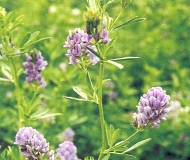
Lucerne
| Name | Lucerne (Medicago sativa) |
|---|---|
| Description | Widely grown perennial legume with its main growth in spring, summer and autumn. It is best suited to a wide range of well‑drained, slightly acid to alkaline soils (pHCa 5.2 - 7.5). Drought resistant. For good persistence it must be grazed or cut on rotation. Can dry out soil profiles to depth. Usually sown in autumn or in spring (irrigated) when the soil temperature is high enough and there is sufficient moisture for establishment. Inoculant Group AL. |
| Sowing rate | dryland 1-5 kg/ha; irrigated 10-15 kg/ha. |
| Minimum average annual rainfall | 375 mm Southern NSW and 400 mm Northern NSW. |
| Select varieties on the basis of | Late autumn/winter growth: Select winter activity where winter feed/production is important, where seedling vigour is essential and where persistence is of secondary importance over short-term production. Semi winter dormant and winter dormant types tend to be more persistent under grazing systems that do not allow for adequate rest. Insects Spotted alfalfa aphid: Do not grow any variety that is not resistant to spotted alfalfa aphid. Not all varieties marketed are resistant (e.g. Hunter River). Blue green aphid: Resistance is highly desirable. Not all varieties marketed have resistance (e.g. Hunter River). Diseases Resistance to disease is of much greater importance when lucerne is grown under irrigation than when grown dryland. Phytophthora root rot: Resistance is essential under irrigation and desirable on poorly drained soil types dryland. Anthracnose: Desirable to have at least moderate resistance under irrigation and in humid environments. (Note that Anthracnose is the stem symptom of the disease Colletotrichum crown rot). Bacterial wilt: Resistance is desirable on some river systems only (seek local advice). Stem nematode: Resistance desirable on some river systems only (seek local advice). Potential hay quality: Highly winter active varieties may be more stalky especially as lucerne stands thin. Local productivity and persistence: Consult local trial information if available. See Appendix IV for ratings on winter growth, insects and diseases. |

More information
- Lucerne varieties (Primefact 1306)
- Lucerne (Agnote DPI-269)
- Lucerne for pasture and fodder (Agfact P2.2.25)
- Introduction to selecting pastures in NSW (Primefact 1539)
- Producing quality lucerne hay - (PDF, 2.34 MB) (www.agrifutures.com.au)
- Producing quality lucerne hay - purchase book (www.agrifutures.com.au)

